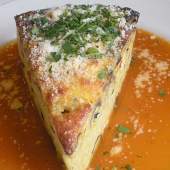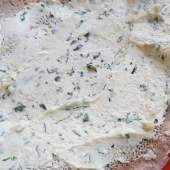Easter

Hot cross buns! Hot cross buns!
One a penny, two a penny,
Hot cross buns!
If you have no daughters, give them to your sons;
One a penny, two a penny,
Hot cross buns!
– Mother Goose
The word “Easter” is said to have been coined from Eostre, who was the Anglo-Saxon goddess of the spring and sunrise (we call the direction of the sunrise “east” because of her). Just the name conjures up images of brightly colored eggs being hunted on green lawns by children in their Sunday best; decorated baskets of jelly beans, chocolate rabbits, and marshmallow chicks; gardens blooming with daffodils, hyacinths, and tulips; and sumptuous pastel-hued repasts with family and friends. A celebration of the Resurrection of Christ, Easter is a joyous day that for Christians (and some non-Christians, too) represents rejuvenation and rebirth (and perhaps also the arrival of spring), and the traditional foods connected with this religious holiday are highly symbolic. Here are a few, and some possible origins and meanings…
First, why are rabbits (and colored eggs) associated with Easter? According to The Goddess Guide, Eostre rescued a bird that was freezing to death by turning it into a rabbit “so its fur would keep it warm – but the rabbit still laid eggs like a bird. In one version of the story, the bunny paints and decorates the eggs as a gift to Eostre to show his loyalty and love.” So it is because of Eostre that Easter baskets contain grass like a bird’s nest as a place for the eggs to rest, and also candy shaped like bunnies. And that basket might be delivered by the Easter Bunny, a German-Lutheran creation of the late 1600s – an entity that seems to have operated similarly to Santa Claus, delivering eggs, sweet treats, and gifts to children whose parents had judged them to have been “good” prior to Eastertide.
There is an alternate and more directly religious story about why Easter eggs are colored, having to do with Mary Magdalene. Holding a simple egg in her hand in the presence of the emperor as she joyfully tried to spread the word about the Resurrection, the emperor laughed at her, not buying it, and scoffed that Jesus rising from the dead was about as likely as her egg turning bright red. Which, magically, it did…right in front of him.
Much later, the Eastern Europeans took egg-decorating to a whole new level, with goldsmith Carl Fabergé creating the exquisite and detailed jeweled eggs that became a great favorite with the Russian royal family and are still admired worldwide today.
Decorated Easter eggs
And the eggs themselves? In Orthodox churches, it is still customary to abstain from eggs during the 40 days of Lent…in order to preserve them during that span, they were hardboiled so they could be enjoyed once Lent came to an end. (Have Easter eggs left over? Make deviled eggs, or egg salad.)
Okay, so why do we eat lamb? And if not lamb, ham? According to legend, lamb is traditional for Easter because, as scholars have surmised, if Jesus ate meat during the Last Supper, it would likely have been lamb. Also, the Gospel of John refers to Jesus as “the lamb of God,” as in “sacrificial lamb.” So, since Biblical times, lamb in connection with Easter has been considered good luck – and if you don’t eat meat, a lamb cake will do. As far as ham goes, its inclusion was really for pure expedience – as many cultures put up salted pork for winter, it was the first meat that was ready to eat in the spring before other fresh varieties were available to them. Today, of course, we can choose either…or both.
Easter meals are not complete without a variety of sweet, fruited breads – especially hot cross buns, which are topped with a cross of white icing, but not served hot. Here is an interesting story about them, from food writer Regula Ysewijn:
“In London’s East End you can find a pub called The Widows Son, named after a widow who lived in a cottage at the site in the 1820s. The widow baked hot cross buns for her sailor son who was supposed to come home from the sea on Good Friday. He must have died at sea as he never returned home, but the widow refused to give up hope for his return and continued to bake a hot cross bun for him every year, hanging it in her kitchen with the buns from previous years. When the widow died, the buns were found hanging from a beam in the cottage…to this day, every Good Friday, the ceremony of the Widow’s Bun is celebrated, and members of the Royal Navy come to The Widows Son pub to place a new hot cross bun into a net hung above the bar.”
Colored eggs, chocolate rabbits, lamb and ham dishes, hot cross buns…there’s no denying that Easter is a happy time for family get-togethers indulging in everything we love about spring. Gather some spring flowers for the table, and enjoy!





